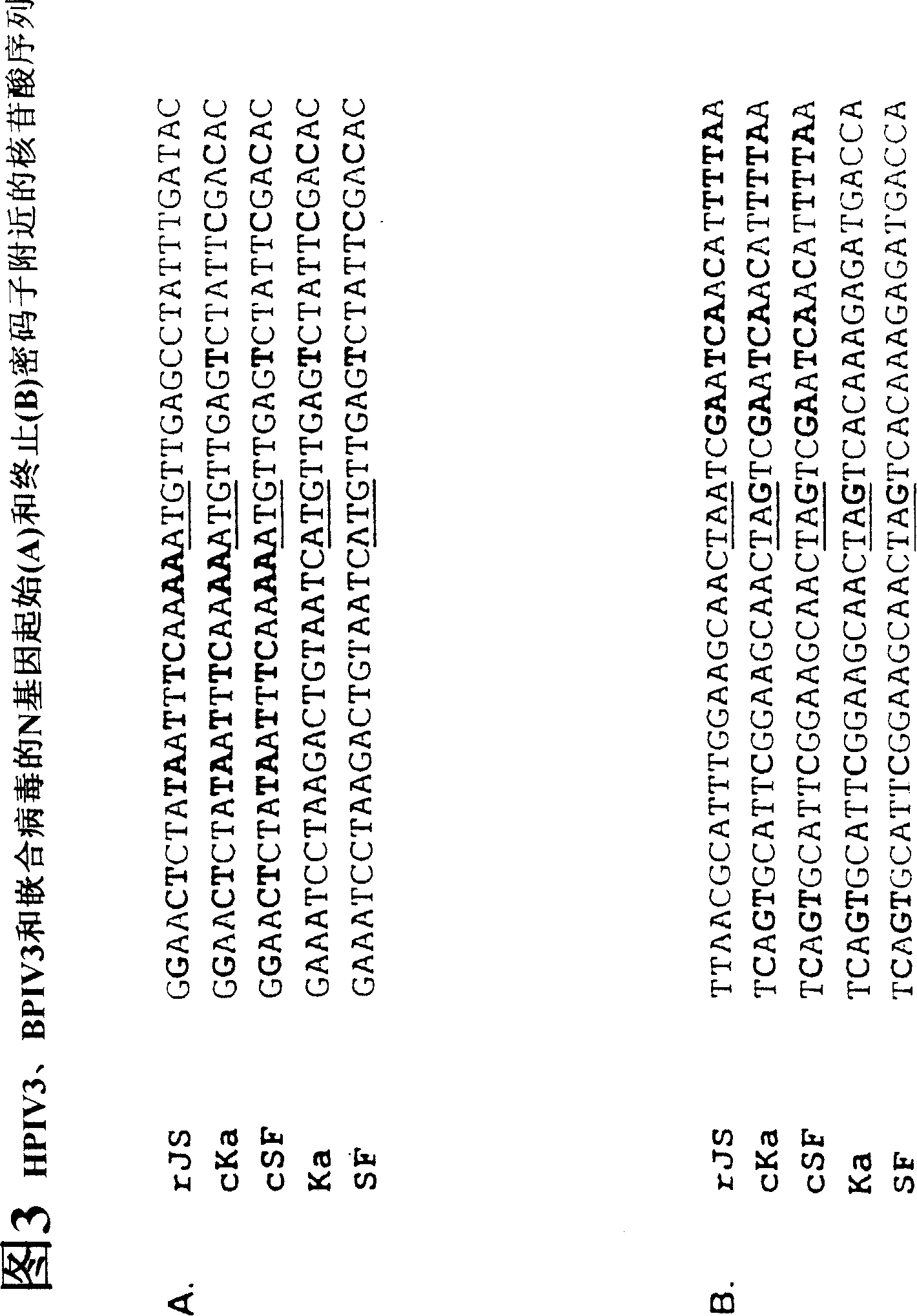Attenuated human-bovine chimeric parainfluenza virus (PIV) vaccines
A parainfluenza and virus technology, applied in the direction of viruses, viral peptides, antiviral agents, etc.
- Summary
- Abstract
- Description
- Claims
- Application Information
AI Technical Summary
Problems solved by technology
Method used
Image
Examples
Embodiment 1
[0199] Construction of antigenomic cDNA encoding chimeric HPIV3 / BPIV3 and infectious virus recovery
[0200] The following three example studies identify proteins that contribute to host range restriction of BPIV3 in primates. The method is to replace the N protein of wild-type HPIV3 virus with the corresponding part on BPIV3. This replacement was accomplished by recovering infectious PIV from cDNA using the reverse genetics system described above. This study started with BPIV3N because, compared to other HPIV3 and BPIV3 proteins, this protein has modest differences in the amino acid sequence of its HPIV3 counterpart (see Example I).
[0201] A chimeric recombinant virus was constructed in which the N ORF of the HPIV3JS strain was replaced by that of the BPIV3Ka or SF strain (Figure 1). These chimeric viruses possess the HN and F glycoproteins of the HPIV3 parent and induce high levels of immunity to HPIV3 in primates. Two chimeric viruses were successfully obtained. A...
Embodiment II
[0210] Replication of HPIV3 / BPIV3 chimeric virus in cell culture
[0211] Efficient replication of live attenuated virus vaccines in tissue culture cells is a feature of the human-bovine chimeric PIV of the present invention, thus enabling efficient production of recombinant vaccine materials. Multicycle replication of rJS parent, cKa, Ka parent, cSF and SF parent in bovine cell line (MDBK) and simian cell line (LLC-MK2) by the method described above (Tao et al., 1998, incorporated herein by reference) To determine, ie, the virus infected the cells at a MOI of 0.01, samples were collected (in triplicate) over a period of 5 days (Figure 5). These chimeric viruses replicated as efficiently in both cell lines as their human or bovine parental viruses, without significant delays in replication, or significant reductions in the resulting virus titers. In either case, the chimeric virus replicated to 10 7.0 TCID 50 / ml (i.e., far greater than the live attenuated human or bovine...
Embodiment III
[0213] Evaluation of Attenuation and Protection Efficiency of HPIV3 / BPIV3 Chimeric Viruses in Rhesus Monkeys
[0214] Both BPIV3Ka and SF are attenuated in both the upper and lower airways of rhesus monkeys (van Wyke Coelingh et al., 1988, supra). This attenuated phenotype correlates with attenuation in humans (Karron et al., 1995a, supra), as Ka replication is highly restricted in the upper respiratory tract of sufficiently sensitive seronegative infants and children. Cough, croup, bronchiolitis, or lung disease did not develop in BPIV3-infected vaccinators, suggesting that Ka BPIV3 virus is also attenuated in the lower respiratory tract. Therefore, macaques are considered a widely accepted, reasonably relevant model to assess the attenuation of candidate PIV vaccine viruses and their effectiveness against wild-type PIV.
[0215] rJS, cKa, Ka parent, cSF and SF parent were administered intranasally and intratracheally to rhesus monkeys, 10 per dose per site 5.0 TCID 50 ....
PUM
 Login to View More
Login to View More Abstract
Description
Claims
Application Information
 Login to View More
Login to View More - R&D
- Intellectual Property
- Life Sciences
- Materials
- Tech Scout
- Unparalleled Data Quality
- Higher Quality Content
- 60% Fewer Hallucinations
Browse by: Latest US Patents, China's latest patents, Technical Efficacy Thesaurus, Application Domain, Technology Topic, Popular Technical Reports.
© 2025 PatSnap. All rights reserved.Legal|Privacy policy|Modern Slavery Act Transparency Statement|Sitemap|About US| Contact US: help@patsnap.com



